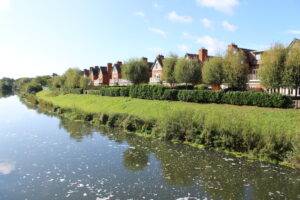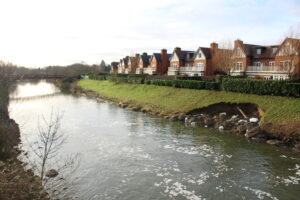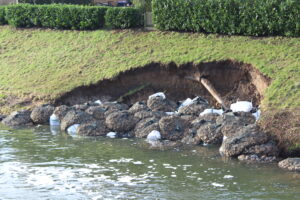Previous bank protectionThe Jubilee River bank downstream of the Taplow Flow Control Structure has failed yet again. You can see a video of how a helicopter was used to place the bags of stone here.
I suspect that the future of the Jubilee River, the River Thames Scheme, the Datchet to Hythe End Flood Improvement Measures project and maybe even the Oxford Flood Alleviation Scheme could all be reviewed as a result of the latest Jubilee River embankment failure. Since the Jubilee River opening in 2002 there have been repeated embankment, bed and structural failures due to a combination of sub-standard design, construction and/or maintenance. It should be noted that the Jubilee River has never even conveyed its design capacity. This image shows existing bank protection downstream of the Taplow Flow Control Structure. This protection was installed after the 2002/3 flood event.




This bank has failed yet again in December 2024 as shown below. Note the proximity of the new houses to the channel – and that the trees have been removed.


Closer examination of the image reveals that the toe of the embankment already had the benefit of previously installed protection that had then failed.

You can see how a helicopter was used to place the bags of stone here
For those who don’t know – there have been MANY Jubilee River bank, bed and structural failures since 2003. I will not spend time here listing the failures but I will just put a few questions (even though I think I know the answers)
Q1: What is total cost to date of Jubilee River bank, bed and structural repairs/improvements since July 2002? (Please supply list identifying the date, the project and the associated costs)
Q2: What is the maximum conveyance capacity of the Jubilee River today in cumecs?
Q3: Who pays for all these failures?
Q4: Who is accountable?
Q5: Will this most recent Jubilee River embankment failure impact the Jubilee River Operating Instructions and the design of similar Flood Alleviation Schemes?
Q6: Why are the local authorities expected to pay for the wooden footbridge repairs/replacements? Surely these sub-standard structures were designed and built by the Environment Agency?
Q7: Somebody needs to explain the purpose of the large diameter and now broken pipe that has been exposed by the embankment failure and is now hanging in space?
Q8: This embankment was previously planted with hundreds of trees. Whatever happened to all the trees?
Q9: If I lived near the failed embankment, would my house insurance be affected?
Q10: River Thames dredging was abandoned about 30 years ago. There are no dredgers, operators or disposal facilities. Should we be reinstating river Thames dredging?
Q11: What should the Environment Agency fear most?
END

